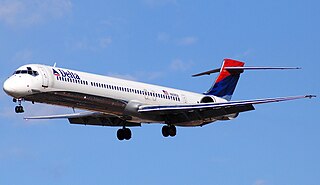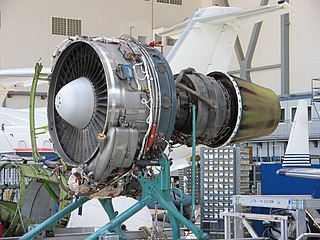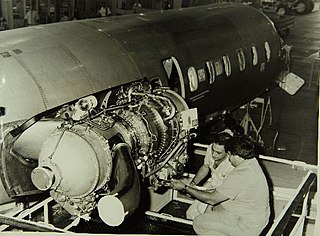Related Research Articles

The McDonnell DouglasMD-90 is an American five-abreast single-aisle airliner developed by McDonnell Douglas from its successful model MD-80. The airliner was produced by the developer company until 1997 and then by Boeing Commercial Airplanes. It was a stretched derivative of the MD-80 and thus part of the DC-9 family. After the more fuel-efficient IAE V2500 high-bypass turbofan was selected, Delta Air Lines became the launch customer on November 14, 1989. The MD-90 first flew on February 22, 1993, and the first delivery was in February 1995 to Delta.

A propfan, also called an open rotor engine, open fan engine or unducted fan, is a type of aircraft engine related in concept to both the turboprop and turbofan, but distinct from both. The design is intended to offer the speed and performance of a turbofan, with the fuel economy of a turboprop. A propfan is typically designed with a large number of short, highly twisted blades, similar to the (ducted) fan in a turbofan engine. For this reason, the propfan has been variously described as an "unducted fan" (UDF) or an "ultra-high-bypass (UHB) turbofan".

The Boeing 7J7 was an American short- to medium-range airliner proposed by American aircraft manufacturer Boeing in the 1980s. It would have carried 150 passengers and was touted as the successor to the successful Boeing 727. It was initially planned to enter service in 1992. This was intended as a highly fuel-efficient aircraft employing new technologies, but it was postponed indefinitely as the price of oil dropped during the 1980s.

The Tupolev Tu-334 was a Russian short-to-medium range airliner project that was developed to replace the aging Tu-134s and Yak-42s in service around the world. The airframe was based on a shortened Tu-204 fuselage and a scaled-down version of that aircraft's wing. Unlike the Tu-204, however, the Tu-334 has a T-tail and engines mounted on the sides of the rear fuselage instead of under the wings. With the nationalisation of the Russian aircraft companies in 2009 to form United Aircraft Corporation it was decided not to continue with the programme.

The McDonnell Douglas MD-94X was a planned propfan-powered airliner, intended to begin production in 1994. Announced in January 1986, the aircraft was to seat between 160 and 180 passengers, possibly using a twin-aisle configuration. An all-new design that was investigated internally since at least 1984, the MD-94X was developed in the mid-1980s to compete with the similar Boeing 7J7. The price of oil would have to be at least US$1.40 per gallon for McDonnell Douglas to build the plane, though. Configuration was similar to the MD-80, but advanced technologies such as canard noseplanes, laminar and turbulent boundary layer control, side-stick flight control, and aluminum-lithium alloy construction were under consideration. Airline interest in the brand-new propfan technology was weak despite claims of up to a 60% reduction in fuel use, and both aircraft were canceled.

The Rolls-Royce AE 3007 is a turbofan engine produced by Rolls-Royce North America, sharing a common core with the Rolls-Royce T406 and AE 2100. The engine was originally developed by the Allison Engine Company, hence the "AE" in the model number.

The General Electric GE36 was an experimental aircraft engine, a hybrid between a turbofan and a turboprop, known as an unducted fan (UDF) or propfan. The GE36 was developed by General Electric Aircraft Engines, with its CFM International equal partner Snecma taking a 35 percent share of development. Development was cancelled in 1989.
The Yakovlev Yak-46 was a proposed aircraft design based on the Yak-42 with two contra-rotating propellers on the propfan located at the rear. The specification of the Samara turbofans was in the 11,000 kg thrust range. Though proposed in the 1990s, production of the Yak-46 never commenced.

The Embraer/FMA CBA 123 Vector was a 1990 turboprop aircraft designed for regional flights, to carry up to 19 passengers. The program arose from a partnership between the Brazilian company Embraer and the Argentine FMA. The project was an advanced turboprop aircraft for its time, including advanced technology in avionics, aerodynamics, and propulsion.

The Progress D-27 is a three-shaft propfan engine developed by Ivchenko Progress, and manufactured by Motor Sich in Ukraine. The gas generator was designed using experience from the Lotarev D-36 turbofan. The D-27 engine was designed to power more-efficient passenger aircraft such as the abandoned Yakovlev Yak-46 project, and it was chosen for the Antonov An-70 military transport aircraft. As of 2019, the D-27 is the only contra-rotating propfan engine to enter service.

The General Electric GE38 is a gas turbine developed by GE Aviation for turboprop and turboshaft applications. It powers the Sikorsky CH-53K King Stallion as the T408.

The Lycoming ALF 502/LF 507 is a geared turbofan engine produced by Lycoming Engines, AlliedSignal, and Honeywell Aerospace. The U.S. military designation for the ALF 502 is YF102.

The Garrett TPF351 is a turboprop engine designed by Garrett Engine Division of AlliedSignal Aerospace Company. Initiated by Garrett in October 1987, the TPF351-20 engine was selected by Embraer to power the Embraer/FMA CBA 123 Vector, a high-speed commuter "pusher" aircraft. It was first tested on May 19, 1989 and then ground tested and flight tested on a Boeing 720 on July 9, 1990. The first prototype CBA 123 was tested on July 18, 1990, followed by a flight to the Farnborough Air Show in September of the same year. Both programs were cancelled in 1992, when the TPF351 was nine months from engine certification.
The Rolls-Royce RB3011 is a prototype propfan engine from Rolls-Royce plc. The design is also known as an "open rotor" engine.

The Pratt & Whitney/Allison 578-DX was an experimental aircraft engine, a hybrid between a turbofan and a turboprop known as a propfan. The engine was designed in the 1980s to power proposed propfan aircraft such as the Boeing 7J7 and the MD-91 and MD-92 derivatives of the McDonnell Douglas MD-80. As of 2019, it is still one of only four different contra-rotating propfan engines to have flown in service or in flight testing.
MPC 75 was an aircraft project of MPC Aircraft GmbH, a subsidiary of Deutsche Airbus. Work on the project was done mainly between 1988 and 1992 in Hamburg, Germany. Predevelopment work was finished, however the project never got the "go ahead" and never made it into full development.
The IAE V2500SF SuperFan was a design study for a high-bypass geared turbofan derived from the IAE V2500. It was offered as the primary engine option for the Airbus A340-200 and 300 in January 1987. Although several customers signed preliminary contracts for this variant, the International Aero Engines board decided in April 1987 to stop the development of the SuperFan, which forced Airbus to partly re-design the A340.

The Progress D-236 was an experimental aircraft engine, a hybrid between a turbofan and a turboprop known as a propfan. Also known as the Lotarev D-236T, the three-shaft geared engine was designed in the 1980s and 1990s to power proposed propfan aircraft such as the Tupolev Tu-334, Ilyushin Il-118, and Ilyushin Il-88.

The Kuznetsov NK-93 was a civilian aircraft engine, a hybrid between a turbofan and a turboprop known as a propfan. The engine was also unique in having a separate duct around the contra-rotating propellers, as most other propfans are unducted. Once described in a respected aviation encyclopedia as "potentially the most fuel-efficient aircraft jet engine ever to be tested", the NK-93 was targeted for derivatives of Soviet/Russian airliners such as the Ilyushin Il-96, Tupolev Tu-204, and Tupolev Tu-330. Five in-flight engine tests were conducted on the NK-93 from December 2006 to December 2008.

The Allison T56 turboprop engine has been developed extensively throughout its production run, the many variants are described by the manufacturer as belonging to four main series groups.
References
- ↑ Air International 7/1987
- 1 2 "R-R unveils the future". Farnborough First News. Flight International . September 6, 1986. pp. 3–4. ISSN 0015-3710. Archived from the original on April 19, 2014.
- ↑ Allen, Roy (May 1987). "Rolls focuses on existing programs: Contrafan and Propfan get less emphasis". Powerplants. Airline Executive. Vol. 11, no. 5. p. 28. ISSN 0278-6702.